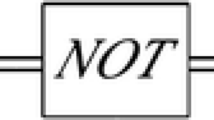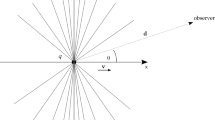Abstract
A communication scenario is described involving a series of events triggered by a transmitter and observed by a receiver experiencing relativistic time dilation. The message selected by the transmitter is assumed to be encoded in the events’ timings and is required to be perfectly recovered by the receiver, regardless of the difference in clock rates in the two frames of reference. It is shown that the largest proportion of the space of all k-event signals that can be selected as a code ensuring error-free information transfer in this setting equals ζ(k)−1, where ζ is the Riemann zeta function.

Similar content being viewed by others
References
Shannon, C.E., A Mathematical Theory of Communication, Bell Syst. Tech. J., 1948, vol. 27, no. 3, pp. 379–423.
Csiszár, I. and Körner, J., Information Theory: Coding Theorems for Discrete Memoryless Systems., Cambridge, UK: Cambridge Univ. Press, 2011, 2nd ed.
Einstein, A., Zur Elektrodynamik bewegter Körper, Ann. Phys., 1905, vol. 322, no. 10, pp. 891–921.
Mermin, N.D., It’s about Time: Understanding Einsteinas Relativity, Princeton: Princeton Univ. Press, 2005.
Shannon, C.E., The Zero Error Capacity of a Noisy Channel, IRE Trans. Inform. Theory, 1956, vol. 2, no. 3, pp. 8–19.
Riemann, B., Über die Anzahl der Primzahlen unter einer gegebenen Größe, Monatsber. Königl. Preufs. Akad. Wiss. Berlin, 1859, Berlin: Königlichen Akad. der Wissenschaften, 1860, pp. 671–680.
Nymann, J.E., On the Probability that k Positive Integers are Relatively Prime, J. Number Theory, 1972, vol. 4, no. 5, pp. 469–473.
Edwards, H.M., Riemann’s Zeta Function, Mineola, NY: Dover, 2001.
Yeung, R.W., Cai, N., Ho, S.-W., and Wagner, A.B., Reliable Communication in the Absence of a Common Clock, IEEE Trans. Inform. Theory, 2009, vol. 55, no. 2, pp. 700–712.
Shaviv, D., Özgür, A., and Arbabian, A., Communication with Crystal-free Radios, IEEE Trans. Commun., 2018, vol. 66, no. 10, pp. 4513–4520.
Acknowledgements
The author would like to thank the anonymous reviewer for providing several very helpful remarks and corrections to the original version of the manuscript.
Funding
This work was supported by the European Union’s Horizon 2020 research and innovation program, Grant Agreement no. 856967, and by the Ministry of Education, Science and Technological Development of the Republic of Serbia, project no. 451-03-68/2020-14/200156.
Author information
Authors and Affiliations
Corresponding author
Rights and permissions
About this article
Cite this article
Kovačević, M. Signaling to Relativistic Observers: An Einstein–Shannon–Riemann Encounter. Probl Inf Transm 56, 303–308 (2020). https://doi.org/10.1134/S0032946020040018
Received:
Revised:
Accepted:
Published:
Issue Date:
DOI: https://doi.org/10.1134/S0032946020040018




